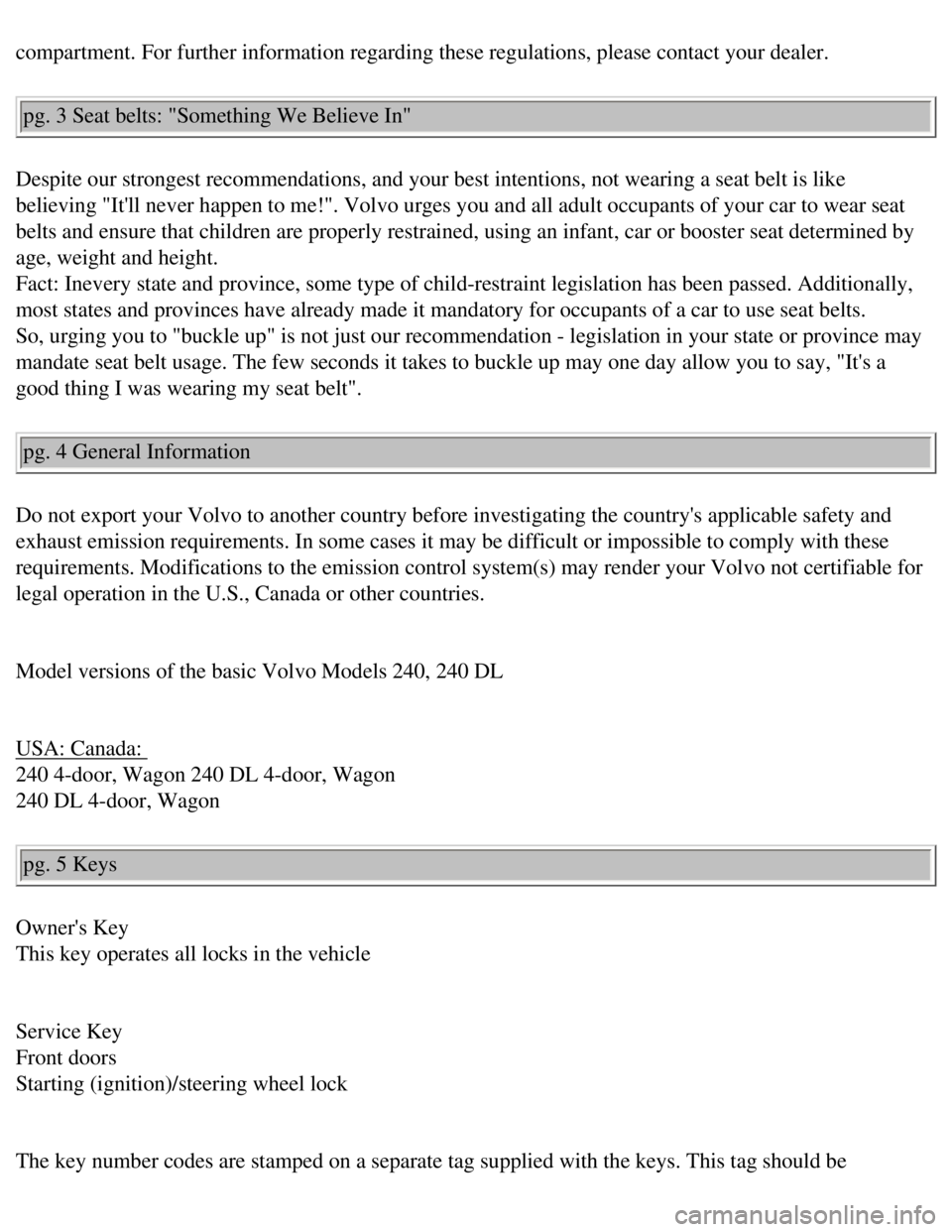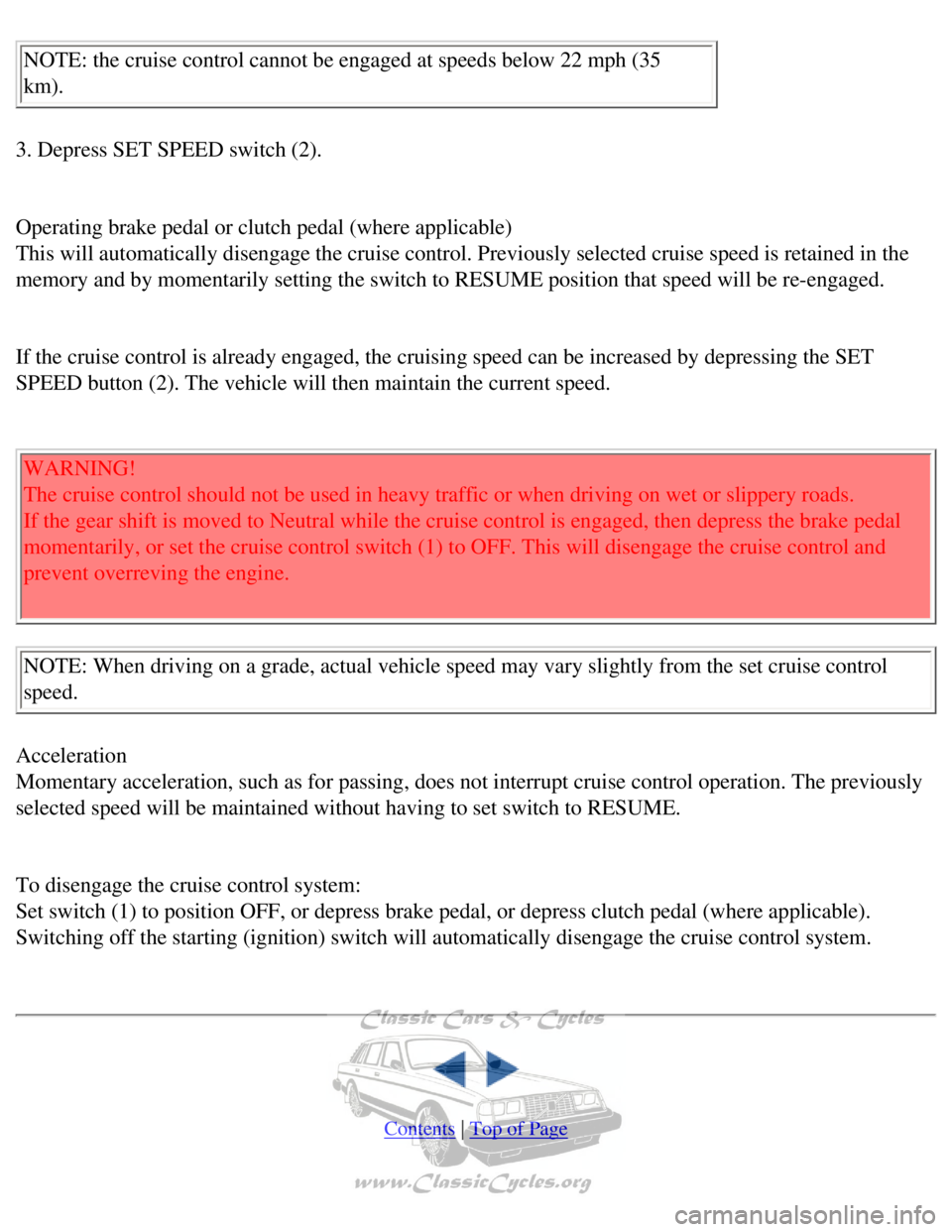Page 3 of 143

Volvo 1990 240 Model
compartment. For further information regarding these regulations, please\
contact your dealer. pg. 3 Seat belts: "Something We Believe In"
Despite our strongest recommendations, and your best intentions, not wea\
ring a seat belt is like
believing "It'll never happen to me!". Volvo urges you and all adult occ\
upants of your car to wear seat
belts and ensure that children are properly restrained, using an infant,\
car or booster seat determined by
age, weight and height.
Fact: Inevery state and province, some type of child-restraint legislati\
on has been passed. Additionally,
most states and provinces have already made it mandatory for occupants o\
f a car to use seat belts.
So, urging you to "buckle up" is not just our recommendation - legislati\
on in your state or province may
mandate seat belt usage. The few seconds it takes to buckle up may one d\
ay allow you to say, "It's a
good thing I was wearing my seat belt". pg. 4 General Information
Do not export your Volvo to another country before investigating the cou\
ntry's applicable safety and
exhaust emission requirements. In some cases it may be difficult or impo\
ssible to comply with these
requirements. Modifications to the emission control system(s) may rend\
er your Volvo not certifiable for
legal operation in the U.S., Canada or other countries.
Model versions of the basic Volvo Models 240, 240 DL
USA: Canada:
240 4-door, Wagon 240 DL 4-door, Wagon
240 DL 4-door, Wagon pg. 5 Keys
Owner's Key
This key operates all locks in the vehicle
Service Key
Front doors
Starting (ignition)/steering wheel lock
The key number codes are stamped on a separate tag supplied with the key\
s. This tag should be
file:///K|/ownersdocs/1990/1990_240/90240_00.htm (3 of 4)12/30/2006 8:\
25:01 AM
Page 5 of 143
Volvo 1990 240 Model
pg. 6 240 DL Sedan
pg. 7 Before you drive
pg. 8Instruments and controls
pg. 10Instruments
pg. 11Warning lights
pg. 12Clock, ambient temperature gauge
pg. 13Oil pressure gauge, voltmeter
pg. 14Ignition switch, turn signals
pg. 15Lighting
pg. 16Windshield wipers, washer nozzles
pg. 18Washer fluid reservoir
pg. 18Rear window demister, heated seat, hazard warning flasher
pg. 19Parking brake
pg. 20Cigarette lighter, ash trays
pg. 21Electrically operated windows
pg. 22Heating and ventilation
pg. 24Air conditioning
pg. 25Audio systems
pg. 26Child safety
pg. 28Seat belts
pg. 30SRS (Supplemental Restraint System)
pg. 32Doors and locks
pg. 33Trunk lid
file:///K|/ownersdocs/1990/1990_240/90240_01.htm (1 of 5)12/30/2006 8:\
25:01 AM
Page 7 of 143

Volvo 1990 240 Model
5 Instruments 10
6 Wiper/washer, tailgate window wiper/washer (wagon) 16
7 Starting (ignition) switch/steering wheel lock 14
8 Air louver 23
9 Radio location 25
10 Air louver 23
11 Glove box -
12 Air louver 23
13 Fuse box 81
14 Hood release handle 34
15 Horn -
16 Cigarette lighter 20
17 Rear window demister 18
18 Hazard warning flashers 18
19 Air conditioning (some models) 24
20 Seat belt reminder light 28
21 Heating and ventilation 22
22 Gear lever or gear selector 45, 46
23 Ash tray 20
24 Storage compartment -
25 Electrically-operated windows (certain models only) 21
26 Control for electrically operated side mirrors (certain models only)\
-
27 Parking brake 19
28 Electrically-operated window, right front door (certain models only)\
21
29 Seat belt release buttons 28
30 Seat heaters 19
31 Seat belt reminder light 28
32 Ash tray 20
The pages in this section provide a detailed description of the vehicle'\
s instruments and controls.
Note that some vehicles may be equipped differently, depending on model,\
special legal requirements,
etc. pg. 10 Instruments
file:///K|/ownersdocs/1990/1990_240/90240_01.htm (3 of 5)12/30/2006 8:\
25:01 AM
Page 10 of 143

Volvo 1990 240 Model
pg. 11 Warning lights
The warning lights described on this page should never be on when drivin\
g
When the ignition is turned on, and before the engine starts, all of the\
warning lights should be on to test
the function of the bulbs. Should a light not go off after the engine ha\
s started, the system indicated
should be inspected. (However, the parking brake reminder light will no\
t go off until the parking brake
is fully released.)
Alternator warning light (red)
If the light comes on while the engine is running,
check the tension of the alternator drive belt as soon
as possible. (See section titled "Cooling system".)
NOTE: This warning light is illuminated if the
alternator is not charging. However, alternator,
parking brake, brake failure, and bulb failure will
be illuminated at the same time due to the design
of the system
Parking brake reminder light (red)
This light will be on when the parking brake
(hand brake) is applied. The parking brake lever
is situated between the front seats. Canadian
models are equipped with this warning light:
Bulb failure warning light (yellow)
The light will come on if any of the following bulbs
are defective:
one of the lower beams
one of the tail lights
one of the brake lights (when the brake pedal is
depressed).
See section on "Replacing Bulbs."
Oil pressure warning light (red)
If the light comes on during driving, the oil
pressure is too low. Stop the engine immediately
and check the engine oil level. See section titled
"Engine Oil". Do not continue to drive the car
with this light on.
After hard driving, the light will come on
occasionally when the engine is idling. This is
normal, provided it goes off when the engine
speed is increased.
file:///K|/ownersdocs/1990/1990_240/90240_02.htm (1 of 4)12/30/2006 8:\
25:02 AM
Page 14 of 143
Volvo 1990 240 Model
pg. 14 Starting (ignition) switch, Turn signals
Starting (ignition) switch/steering wheel lock
O Locked position: remove the key to lock the steering wheel.
I Intermediate position: certain circuits (heater blower, cigarette lig\
hter, accessories, etc.) on.
II Drive position: key position when engine is running.
III Starting position: release the key when engine starts. The key retur\
ns automatically to
drive position.
The steering wheel lock may be under tension when the car is parked. Tur\
n the steering wheel slightly to
free the ignition key.
A chime will sound if the starting key is in the ignition lock and the f\
ront door on the driver's side is
open. The chime will also sound if the headlights or parking lights are \
on when the door is open. The
chime goes off when the front door is closed.
file:///K|/ownersdocs/1990/1990_240/90240_03.htm (1 of 7)12/30/2006 8:\
25:02 AM
Page 16 of 143
Volvo 1990 240 Model
Rear fog lights
The rear fog lights are considerably brighter than the normal tail light\
s and should be used only when
atmospheric conditions, such as fog, rain, snow, smoke or dust reduce th\
e daytime or nighttime visibility
of other vehicles to less than 500 ft. (152 meters). (The headlights \
must be switched on.)
Note: Local regulations governing the use of these lights may
vary.
Headlights and position lights
0 All lights off*
Parking lights on*
Headlights and parking lights on
Switch from upper to lower beams, and vice versa, by moving the turn sig\
nal switch lever on the left
side of the steering column towards the steering wheel. The parking ligh\
ts can be used without switching
on the starting (ignition) key.
* Canadian models equipped with daytime running lights: Headlights and p\
arking lights on when
file:///K|/ownersdocs/1990/1990_240/90240_03.htm (3 of 7)12/30/2006 8:\
25:02 AM
Page 17 of 143
Volvo 1990 240 Model
starting (ignition) switch is switched on.
A chime will sound if the starting (ignition) key is in the switch loc\
k when the door is open. The chime
goes off when the driver's door is closed. If the headlight switch is in\
position
, all lights will go out
when starting (ignition) switch is switched off.
Instrument panel lamps rheostat
Clockwise - brighter
Counterclockwise - dimmer
pg. 16 Windshield wipers, Tailgate window wiper, Washer nozzles
Wiper/washer
1 Intermittent wiper
file:///K|/ownersdocs/1990/1990_240/90240_03.htm (4 of 7)12/30/2006 8:\
25:02 AM
Page 20 of 143

Volvo 1990 240 Model
NOTE: the cruise control cannot be engaged at speeds below 22 mph (35
km).
3. Depress SET SPEED switch (2).
Operating brake pedal or clutch pedal (where applicable)
This will automatically disengage the cruise control. Previously selecte\
d cruise speed is retained in the
memory and by momentarily setting the switch to RESUME position that spe\
ed will be re-engaged.
If the cruise control is already engaged, the cruising speed can be incr\
eased by depressing the SET
SPEED button (2). The vehicle will then maintain the current speed.
WARNING!
The cruise control should not be used in heavy traffic or when driving o\
n wet or slippery roads.
If the gear shift is moved to Neutral while the cruise control is engage\
d, then depress the brake pedal
momentarily, or set the cruise control switch (1) to OFF. This will di\
sengage the cruise control and
prevent overreving the engine.
NOTE: When driving on a grade, actual vehicle speed may vary slightly fr\
om the set cruise control
speed.
Acceleration
Momentary acceleration, such as for passing, does not interrupt cruise c\
ontrol operation. The previously
selected speed will be maintained without having to set switch to RESUME\
.
To disengage the cruise control system:
Set switch (1) to position OFF, or depress brake pedal, or depress clu\
tch pedal (where applicable).
Switching off the starting (ignition) switch will automatically diseng\
age the cruise control system.
Contents | Top of Page
file:///K|/ownersdocs/1990/1990_240/90240_03.htm (7 of 7)12/30/2006 8:\
25:02 AM